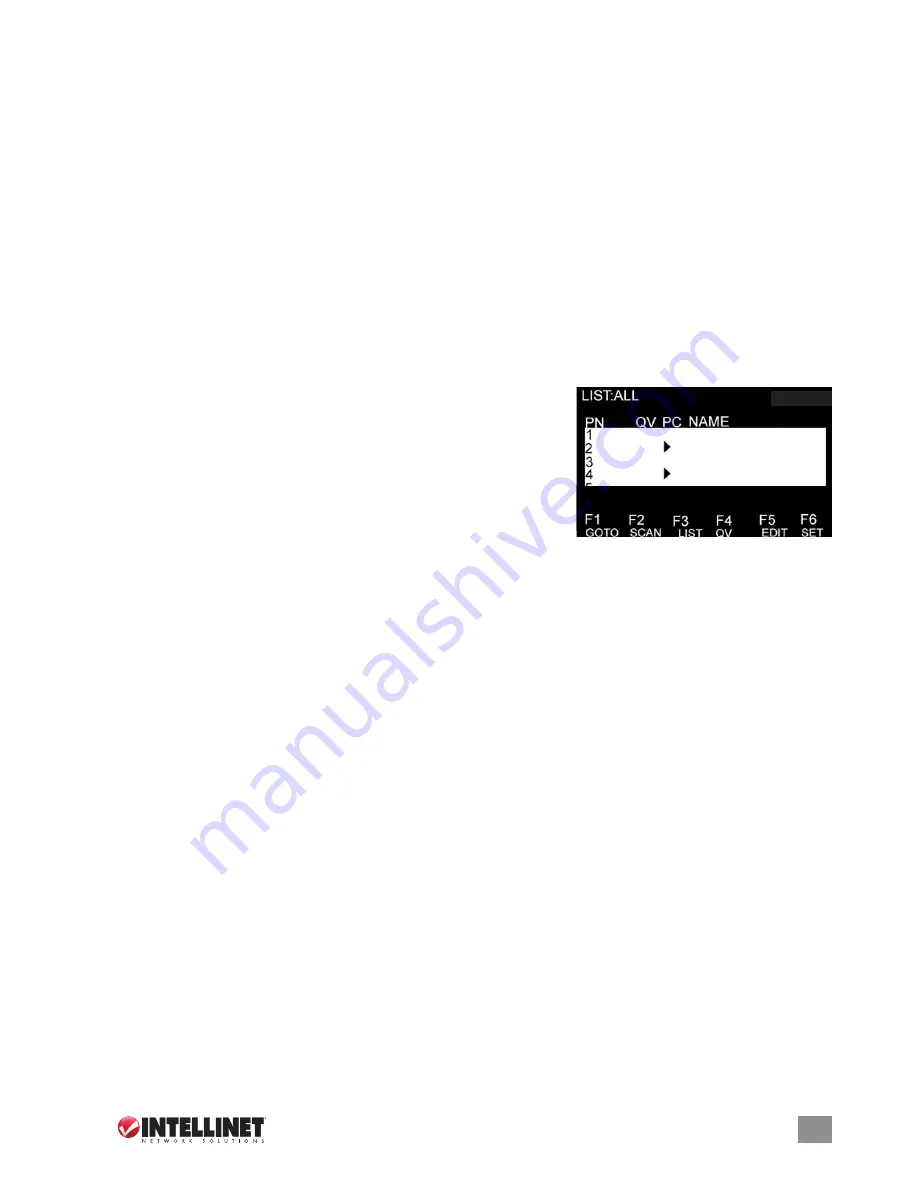
3
ENGLISH
Powering Off and Restarting
If the switch needs to be turned off, follow these steps before turning it back on:
1. Turn off all computers attached to the switch.
2. If the switch is operating under external power, disconnect the power adapter from the switch.
3. Wait 10 seconds, then re-connect the power adapter and turn on the computers.
On-Screen Display (OSD)
In addition to selecting a networked computer by pressing its corresponding Port Selection button on the front panel of the switch, all
computer control and switching procedures can be performed using the On-Screen Display (OSD).
• To display the main menu, press <
CTRL
> on the keyboard twice.
• If the OSD menu is set as “Console locked,” you need to input a password each time the main menu appears. If no password has been
set, just press <Enter> to display the main menu. There are two passwords in the OSD: the user password, which is not pre-set; and the
factory password, which is “INTELLINET.”
• The OSD always starts at the List screen, with the highlight bar in the same position as when the OSD was exited.
Navigation
• To exit the OSD, press <Esc>.
• To move up and down through the menu one line at a time, use the Up and Down Arrow keys. If there are more listed entries than what
can appear on the main screen, the screen will scroll.
• To activate a port, move the highlight bar to it and press <Enter>.
• After you select a port, the OSD menu automatically disappears and the port currently selected is indicated.
Main Screen Headings
PN
— This column lists the port numbers for all the CPU ports on the installation. The simplest way to access a particular computer is to
move the highlight bar to it, then press <Enter>.
QV
— If a port has been selected for Quick View scanning,
4
displays in this column.
PC
— If a computer is powered on and on line,
4
displays in this column.
NAME
— Any name assigned to a computer appears in this column.
Functions
The OSD can be controlled and re-configured using the functions described below.
F1 GOTO
— GOTO allows you to switch directly to a port by keying in either the
computer’s name or its port number (PN).
• To use the name, highlight “NAME,” press <Enter>, input the name of the computer,
then press <Enter> to confirm. If there is a matching name, it will display on the
screen. Press <Enter> to switch to that port.
• To use PN method, highlight “PN,” press <Enter>, input the port number, then press <Enter> to switch. If the port number is invalid,
it will prompt you to try again.
• To return to the main menu, press <Esc>.
F2 SCAN
— This allows you to automatically scan from the current selected port through any active and connected computers. While
scanning, a small window on the screen indicates the current port number. To stop scanning (and continue viewing the last computer
scanned), press the space bar. The scan interval can be set by the user.
F3 LIST
— This lets you broaden or narrow the range of ports displayed on the main screen. Many of the OSD functions described below
only operate on the computers listed on the main screen (selected by using this function).
• ALL lists all of the ports in the configuration.
• QVIEW lists only the ports that have been selected as Quick View ports.
• POWERED ON lists only the ports that have their attached computers powered on.
• POWERED ON + QVIEW lists only the ports that have their attached computers powered on and have been selected as Quick View
ports.
• QVIEW + NAME lists only the ports that have been selected as Quick View ports and have been assigned names.
• NAME lists only the ports that have been assigned names.
Highlight a function and press <Enter>. When the confirmation icon displays alongside your selection, press <Enter> to return to the
OSD main screen with the newly formulated list displayed.
F4 QV
— This lets you select a port as Quick View. Highlight a port and press <F4>. The
s
icon displays to confirm your selection. Press
<F4> again and the icon disappears.
F5 EDIT
— This lets you create or edit the name of a port. Press <F5> and a pink edit box will appear on the screen. Input a name, press
<Enter>, and the port name will be set and displayed.
F6 SET
— This lets you configure the OSD menu. Highlight an option and press <Enter> to change settings.
• CHANNEL DISPLAY MODE offers three options for what appears in the tip window:
- PN + NAME
- PN (port number only)
- NAME
• CHANNEL DISPLAY DURATION offers two options for the length of time the tip window remains on the screen:
- 3 SECONDS
- ALWAYS ON
• CHANNEL DISPLAY POSITION lets you re-position the tip window. When the window appears on the screen, use the arrow keys to
move it, then press <Enter> to set the new position.
• SCAN DURATION offers eight options for the amount of time each connected computer is scanned, ranging from 3 to 60 seconds.
• SET PASSWORD lets you change the current password as directed on screen.
• CLEAR THE NAME LIST lets you remove any names assigned to the ports.
NOTE:
This requires a password.
• RESTORE DEFAULT VALUE lets you return to the default settings.
NOTE:
This requires a password. The user password will be cleared,
but not the factory password.
• LOCK CONSOLE means you cannot switch or scan once this function is activated. Selecting this same option when the console is
locked will unlock it.
NOTE:
Both of these options require a password.
















